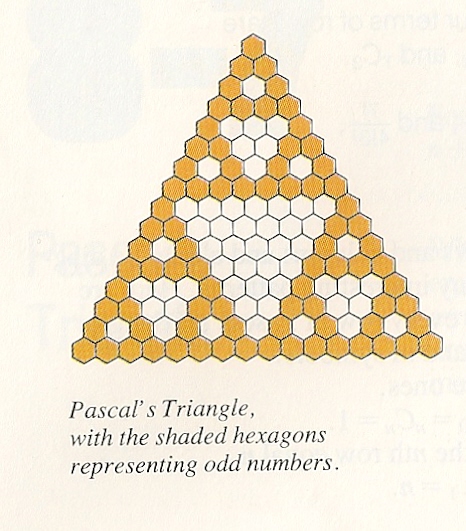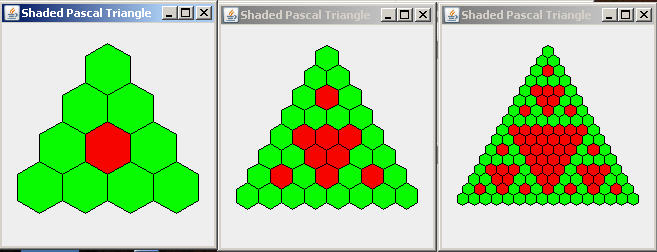CSSE 230
Pascal's Christmas tree (100 points)
Objectives
-
Practice with iteration in Java.
-
Review of implementing graphics classes based on a given specification.
-
Arithmetic with large integers.
-
Pair programming with a partner.
Overview
The following picture appears in the University of Chicago School Math Project's high-school book Functions, Statistics, and Trigonometry:

You will write a program that draws pictures like this.
If you use green for odd numbers and red for even, the
picture will resemble the title of the assignment. For an introduction to
Pascal's Triangle, see
http://en.wikipedia.org/wiki/Pascal_triangle .
Consider which rows do not contain any even numbers. They
are rows 0, 1, 3, 7, 15, ... Then consider this
table that maps k to the corresponding "all odd" row:
| k |
r(k) = corresponding row with only odd
numbers
|
| 0 |
0 |
| 1 |
1 |
| 2 |
3 |
| 3 |
7 |
| 4 |
15 |
Your program should prompt the user for a number k≥2
and a window height, and
then pop up a window on which it draws the shaded triangle of
regular hexagons whose last row is r(k). Ideally,
your triangle should fit in the window for any k, but making it
perfect is not easy. It should certainly fit in the window for
larger values of k (say, k>=4), but may overlap a little for k=2 and/or
k=3.
Adjusting the triangle to be centered and to mostly fill the window is
one of the most difficult parts of this assignment, and so it will have
a non-trivial impact on your score.
That's all! But this task is easier said than done.
There are several places along the way where you are likely to
encounter snags. Each of those is an opportunity for you to learn
something and adjust your approach.
The following examples show the results for k=2, 3, and 4 and a small
window size. Notice that for a given window size, the triangle is
the same size for each k; the hexagon size gets smaller as k
gets larger k.

You can find the starting code in the PascalChristmasTree
project in your pair's SVN repository.
Partners
Your instructor will
tell you who your partner is and the name of that repository. You should
plan to use pair programming for all of your coding/debugging work. Certainly you
can split up the tasks of learning about things you need for this
program, but you should write and debug all of the code together.
We recommend tat the partner who feels least sure about programming in
Java be the most frequent driver in your pair-programming sessions.
If both partners have remaining a late day, you may use a late day for
this assignment.
After the project is due, each of you will evaluate your partner;
usually both partners will receive the same score, but if these
evaluations or any other info make us think it is appropriate, we may
give you different grades.
Suggested Incremental Development Path
The following incremental steps may help you to get there. You are not
required to take this path; the only deliverable is a well-written,
well-documented program that produces the correct pictures. If you
follow this path, our best guess is that step 6
is the halfway point in the time required to write and debug this assignment.
-
Write a static method
combinations() that computes the
ith entry of
row j, which is jCi, the number of different
combinations of j distinct items, taken i at a time. One
well-known formula for this is j(j-1)...(j-i+1) / i!.
The following example shows a computation order that may be
preferable: 12C4 =
12 / 1 * 11 / 2 * 10 / 3 * 9 / 4. Note that for all
nonnegative integers i ≤ j, when the formula for
the number of combinations is evaluated in this order, each intermediate value in the
above computation is an integer, and the numbers you have to
deal with are smaller than if you calculate the numerator
for the factorial formula and then divide by the denominator. Of course you will need a
loop to do this computation. [Option: You can
speed up the computation considerably by storing
previously-computed value(s) and using them to compute the next
value, using the formula for an element of Pascal's Triangle
that involves adding the two elements above it in the
triangle. That is not required for this assignment.
Can you think of other ways to speed up the computation?].
Test your
method.
-
Write nested loops to print Pascal's triangle to the
console. Don't worry about formatting, except that you
should get the correct numbers in the correct order for each row.
-
Create a graphical program that repeatedly draws some shape
(it doesn't matter what shape) in a centered triangular pattern.
This is a "for practice only" program.
-
Write a static method
that produces and returns a regular hexagon
Shape that can by drawn or
filled by a Graphics2D object. Our suggestion is that you
produce a Path2D.Double object instead of a Polygon object,
because the latter can have coordinates that are not integers.
The moveTo() and lineTo() methods of the
Path2D.Double class may be useful.
At what angle from the x-axis should the first vertex be in
order to draw hexagons that are oriented like the ones in
the pictures? We found that the following signature
made the method easy to implement:
public Path2D.Double hexagon(double centerX, double centerY, double radius)
Test your method by drawing some hexagons.
Draw a row of contiguous regular hexagons across the screen.
What is the relationship between the width of a hexagon and
its radius? -
Draw a second row of hexagons below the first, positioning
them so that they form the honeycomb pattern as in the
pictures. As a function of the hexagon radius, what is the
vertical distance between the top of one row and the top of
the row below it?
-
Determine the rectangular area in which the triangle is to
be drawn, based on the window width and height and the
minimum inset you want to have around the triangle. Then,
based on k, determine the radius of the largest hexagons
that you can use to draw the triangle inside this rectangle.
-
Draw the triangle of hexagons, containing the correct number
of rows, based on k. Test it for k=2, 3, and 4.
Note that there is some commented-out code that draws a
horizontal line at the midpoint of the window.
Uncommenting this line and running the code can provide a check to see if you really have
the triangle centered in the window.
Also note that there seems to be a minimum window width, so
if you you call the constructor with a very small second
argument, the triangle will be the correct size, but the
window will be "too wide", so the triangle will not be
centered.
- Before you draw each hexagon, fill it with the correct
color, based on the parity of the corresponding value in Pascal's triangle.
- Try larger values of k. Does your code still work? If not,
fix it. For a height 750 window, our
pictures look good and draw instantly up through k=8.
For k=9, it takes a few seconds to draw, and the hexagons
are so small that the black lines of their borders begin to
obscure the red and green. For k=10 (1024 rows of
the triangle), the hexagons are so small that the black
borders fill the entire triangle; it takes more than a
minute to draw it unless we use a very efficient algorithm;
an efficient algorithm can do it in a couple of seconds. Your code should work for any value of k, although it only
has to have good-looking pictures for up to k=8.
- Commit the project to your repository often. Be sure that
your code contains both authors' names.
Provided Code
To enable you to focus on the non-routine parts of this program, we have
provided you with some starting code. You should read and
understand (ask if you don't understand) the code in PascalViewer.java,
but you should not have to change it at all. In PascalComponent.java,
we have given you a basic framework and some variable declarations that you may find helpful.
Feel free to change anything except the
signature of the constructor, since we may write test code that calls the constructor directly
without using the code in PascalViewer.java. You may wish to write additional methods
to help with your computations.
Prohibition
You may not use a 2-dimensional array in your code.
Doing so would require a lot of space, and it is unnecessary.
Everything can be calculated one row at a time.
Turn-in Instructions
Turn-in your programming work by committing it to your
SVN repository. The grading
rubric/checklist is available
here: GradingChecklist_PascalChristmasTree.doc
Start early
A few pairs may finish this
program in one or two sessions
together. But
many pairs will need multiple
sessions over several days in
order to get his done.

